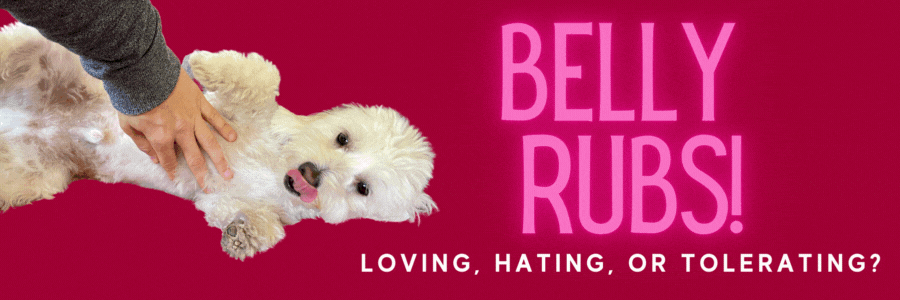Do dogs like belly Rubs?
By Lisa Radosta DVM, DACVB
(Here is the audio track, but don’t miss the videos below!)
A smile is one of the most basic and universally understood human expressions. However, even in the same person, depending on the circumstance a smile can have opposite meanings. Sometimes we might smile when we feel happy. We are also likely to smile when we feel nervous, embarrassed, or stressed. To an observer, our smile may look identical, but on the inside, we may be feeling any number of emotions.
As is often the case there are similarities between dogs and us. One of the most misunderstood dog body language signals is rolling over onto the back. Most people see a dog go belly-up and they can’t resist but go in for the pet. What is more enticing than petting a fuzzy dog tummy? However, when a dog rolls over onto his back, he is very often expressing fear, anxiety, or conflict. With this action, dogs are often saying, “STOP. Back off. Please don’t pet me.”
How could this behavior be so misunderstood? Rolling over onto the back is a body language signal expressed first in puppyhood. Puppies may do this during play or when they are scared, anxious, or conflicted. They use it to show the other dog that they are feeling worried about the interaction, they are no threat, and that they need some space. Feeling doubtful that dogs are rolling over onto their backs to express fear or stress? Engage in a little observational science. If you have some extra time, go to a dog park and watch how dogs engaged in healthy play react to another dog who rolls over onto their back. Almost always, if the dog is behaviorally healthy, they will sniff the other dog and walk away, back away or just walk away. Take note if you see any dogs petting other dogs with their paws when they see another dog roll over onto their back. (HINT: You are about as likely to see this as you are a Martian walking through the dog park!) Walking away or backing away sends a clear signal back to the dog that rolled over that they have been seen, heard, and understood. There will be no further interaction to cause fear or concern.
You might be thinking that this is unbelievable! Your dog loves belly rubs! Maybe your dog does. Your dog may be one of many dogs that has learned that although human beings clearly do not speak dog well enough to know the original meaning of this body language signal, having a belly rub feels pretty good. People respond in the same way every time so it’s a great way to solicit petting. If that’s your dog, great! However, your dog is probably in the minority. Most dogs express this signal in order to gain some space. Dogs who are worried and anxious often learn that when they ask for space politely by rolling over onto their back, people reach to pet them. These dogs often learn to escalate and growl or even bite when their belly is rubbed because the body language signals that to them seem so obvious we’re not interpreted correctly by their people.
they ask for space politely by rolling over onto their back, people reach to pet them. These dogs often learn to escalate and growl or even bite when their belly is rubbed because the body language signals that to them seem so obvious we’re not interpreted correctly by their people.
You love your dog and you want your dog to feel understood. You want the strongest bond possible and you want him to live his best life. With that in mind, what should you do when your dog rolls over onto his back? Is he lying on his back with his legs flaccid and his tail straight out or a little off to the side? Does he look relaxed? He may be asking for a belly rub. The first thing to do is pause and assess the rest of his body language.
- Is he licking his nose or lips?
- Does he look a little stiff?
- Is he lying on his side and only lifting one of his legs?
- Is he turning his head slightly to look up at you? Does he turn away and ignore you after you move away?
These are all signs that your dog may be fearful, stressed, anxious, or does not want to be bothered.
Even after you have paused and looked at his body language you might still be wondering, “Should I pet him?” When in doubt, take a step back or pull your hand away. If your dog really wants you to pet him, he will get up and nudge you with his nose or his paw. He’ll ask clearly for more petting. Whenever you’re interacting with your dog regardless of his body posture pause every so often and give him a chance to decide if he wants to continue being petted. One of the easiest ways for you to show your dog how much you love him is to try to understand what he’s saying and respond appropriately.
Watch Finley closely in the next video. Do you think he wants or invites the hand to come near him? We can clearly see that he lip-licks and shows his belly, two clear signs that he is saying no. After three repetitions, he continues to be clear about his desire not to be bothered.
The cool thing about understanding your dog is that the more you show him or her that you’re listening the more your bond will grow.

